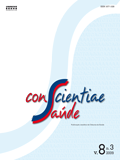Variables associated with bruxism in children and adolescents
DOI:
https://doi.org/10.5585/conssaude.v8i3.1706Palavras-chave:
Bruxism, Prevalence, Sleep.Resumo
The aim of the study was to assess the variables associated with bruxism and its prevalence in school children and adolescents. A group of 680 school children of both genders aged 4 -16 years old was randomly selected. Data were gathered by clinical exam and questionnaires filled out by guardians. Statistical analyses were performed by Chi-square test, Odds Ratio and SPSS package. Some factors like heredity, respiratory problems, headaches, difficulty with falling asleep, sleep talking and the schoolchild’s disquiet temperament were associated with bruxism occurrence. Bruxism prevalence was 43%. No gender differences were found. It could be concluded that bruxism seems to play a significant role in the schoolchildren’s quality of life, and thus deserves proper identification. However, additional studies should be conducted by multidisciplinary teams involving sleep medicine, dentistry and psychology, in order to best understand its etiology.Downloads
Downloads
Publicado
Como Citar
Edição
Seção
Licença
Copyright (c) 2009 ConScientiae Saúde

Este trabalho está licenciado sob uma licença Creative Commons Attribution-NonCommercial-ShareAlike 4.0 International License.
Autores que publicam nesta revista concordam com os seguintes termos:
O(s) autor(es) autoriza(m) a publicação do texto na revista;
O(s) autor(es) garantem que a contribuição é original e inédita e que não está em processo de avaliação em outra(s) revista(s);
A revista não se responsabiliza pelas opiniões, idéias e conceitos emitidos nos textos, por serem de inteira responsabilidade de seu(s) autor(es);
É reservado aos editores o direito de proceder a ajustes textuais e de adequação às normas da publicação;
Autores mantém os direitos autorais e concedem à revista o direito de primeira publicação, com o trabalho simultaneamente licenciado sob uma Licença Creative Commons Atribuição-NãoComercial-CompartilhaIgual 4.0 Internacional;
Autores têm permissão e são estimulados a publicar e distribuir seu trabalho online (ex.: em repositórios institucionais ou na sua página pessoal) já que isso pode gerar alterações produtivas, bem como aumentar o impacto e a citação do trabalho publicado;
Em virtude de aparecerem nesta revista de acesso público, os artigos são de uso gratuito, com atribuições próprias, em aplicações educacionais e não-comerciais.





